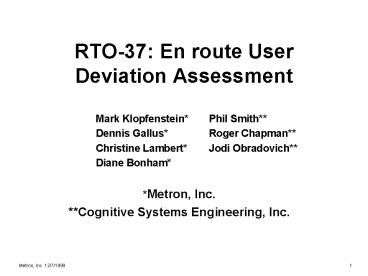RTO37: En route User Deviation Assessment - PowerPoint PPT Presentation
1 / 46
Title:
RTO37: En route User Deviation Assessment
Description:
... in terms of flight deviations and delays are regularly occurring in the NAS? ... Departure Delays for July 12th July 18th 1999, by Arrival Airport, Scheduled ... – PowerPoint PPT presentation
Number of Views:22
Avg rating:3.0/5.0
Title: RTO37: En route User Deviation Assessment
1
RTO-37 En route User Deviation Assessment
- Mark Klopfenstein Phil Smith
- Dennis Gallus Roger Chapman
- Christine Lambert Jodi Obradovich
- Diane Bonham
- Metron, Inc.
- Cognitive Systems Engineering, Inc.
2
Funding Source
- This work was performed under contract to
- Honeywell Technology Center
- (PO 9138312)
- and
- funded by NASAs AATT program
- (Prime Contract NAS2-98005)
3
Questions Addressed
- What problems in terms of flight deviations and
delays are regularly occurring in the NAS? - Where, when and how often are they occurring?
- What is the impact of these problems?
4
Post-Operations Evaluation ToolData Sources
- Archived ETMS data (FAA ATA-200)
- Complete Flight Plan and Flight Amendments
- Actual flight track
- Sectors transited
5
Other Data Sources
- ATCSCC log data
- System restrictions and advisories
- Miles in Trail
- Ground stops
- Ground delay programs
6
Goal
- Develop techniques to identify, quantify, and
understand the nature of inefficiencies in NAS - Apply these techniques on a large-scale
7
Time Periods
- 11-25-1998
- Day before Thanksgiving (historically the busiest
day of the year) - 12-25-1998
- Christmas day (historically the slowest day of
the year) - 1-8-1999
- Bad winter day (widespread snowstorms, many GDPs)
- 1-14-1999
- An unpredictably bad winter day (snow and icing
in Northeast as far south as Richmond, no GDPs,
but many ground stops) - 5-18-1999
- Bad spring day (widespread thunderstorms)
8
Time Periods (cont.)
- April 24-30, 1999
- July 1-31, 1999
- September 20-26, 1999
- October 4-10, 1999
9
Flights Considered in Study
10
Limitations and Caveats
- Bad data filtering (such as negative times)
- Inconsistent reporting of predicted off times
- Display System Replacement (DSR) transition
restrictions - Weather impacts
- Planned air times that include padding
11
Worst Departure Delays for July 12th July 18th
1999, by Arrival Airport, Scheduled Arrival Bin,
Arrival Fix Combinations with more than 48 Flights
12
Ground Delay Programs between7-12-99 and
7-18-1999
13
Worst Air Time Performances for July 12-18,
1999, by Arrival Airport, Scheduled Arrival Bin,
Arrival Fix Combinations with more than 48 Flights
14
Rank Order Correlations of Air Time Delays Across
Different Times of the Year
15
Inefficiencies as Detected by Data Mining Tools
- Holding
- Significant Reroutes
16
Arrival fix/time of day combinations that were
most often held in the air (7/12/99-7/18/99)
17
Rank Order Correlations of Percent Holding Across
Different Times of the Year
18
Flights Filed into Different Arrival Fixes at ATL
19
Routes Filed into ATL through all 4 Arrival Fixes
20
Filed and Actual Routes for Flights Filed Over
HUSKY
21
Data on Some Individual Flights into LOGEN
22
Flights Over LOGEN that were Held
23
Significantly Rerouted Flights
- Track length similarity
- shorter (lt 5)
- same (within 5)
- long (between 5-15)
- longer (gt 15)
- Spatial similarity
- Spatial similarity algorithm
24
Spatial Similarity Examples
25
Significantly Rerouted Flights
Shaded area represent those flights that were
significantly rerouted (36.6 overall)
26
Percent of flights significantly rerouted by time
of year
27
Reroutes by time of day
28
Correlation of Reroutes by Arrival Airport,
Scheduled Arrival Bin, Arrival Fix Combinations
29
Rerouted flights by (CONUS) centers along filed
flight route between 7/12/99 and 7/18/99
30
Rerouted flights by en route sectors along filed
flight route (top 20 CONUS sectors) between
7/12/99 and 7/18/99
31
Rerouted flights by airways along filed flight
route (top 15) between 7/12/99 and 7/18/99
32
Inefficiencies as Indicated by Manual Detailed
Analyses
- Bottlenecks along Select Route Segments
- Miles in Trail (MIT) Restrictions
- Diversions in the NAS
33
Bottlenecks along Select Route Segments
- Describe briefly what we did?
34
Flights Flying J80 at Same Time as 2200-2300Z
Arrivals at CVG
35
Departure Delays of other Flights using J80
36
Miles-in-Trail Restrictions
- What is the frequency of miles in trail?
- What were the reasons for these restrictions?
- What destinations were most often impacted?
- How many flights were impacted?
37
Number of MIT restrictions by day
38
Weekly trends of MIT
39
MIT by Reason Affected Destination
40
Flights Impacted by MIT
- On average 13.5 flights were impacted for by each
restriction (range 1 to 442) - ZJX put a 20-mile MIT restriction on ZTL for
flights arriving in Atlanta (ATL) between 1215
and 1445 due to weather that affected 60 flights. - ZID put a 30-mile MIT restriction on ZAU for
flights arriving in Atlanta (ATL) between 1745
and 1845 due to weather that affected only 6
flights. - On average 8.5 flights affected per MIT
restriction hour - On average1332 flights were affected per day
- Ranged from 300 (9 October 1999) to 1912 (28
April 1999) flights affected per day
41
MIT Impacted Flights by Reason Affected
Destination
42
Diversions
43
Diversions by User Class
44
Daily Variation in Diversions
45
Rank-ordered Count of Air Carrier Diversions by
Day
46
Diversion Delays































